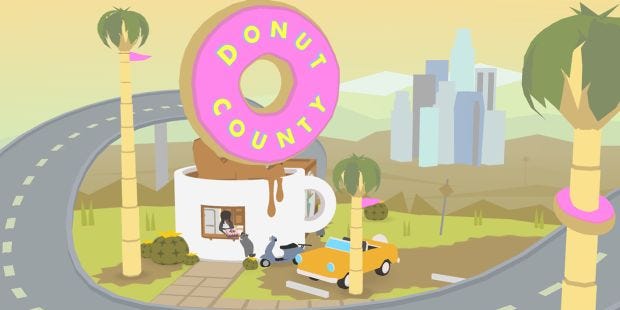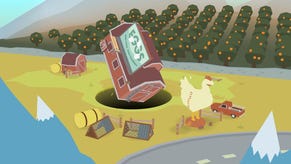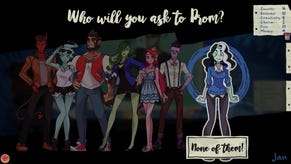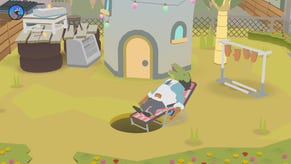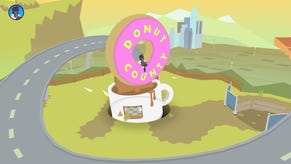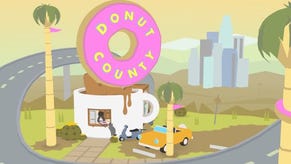Hopi-less: How Kachina Became Donut County
The Failure Workshop
Two years ago, GDC 2013's Experimental Gameplay Workshop featured a game that had the crowd cheering and applauding in delight. It was Ben Esposito (The Unfinished Swan) with Kachina. This year's GDC revived an old favourite of the show, the Failure Workshop. This was a chance for developers to share the stories of their disasters, and the good or bad that came from them. And during it, Esposito generously and honestly told an engrossing and humbling tale of how Kachina became Donut County [official site], and the hard cultural lessons he learned along the way.
Kachina, as presented at GDC 13, was a beautiful and completely novel puzzle game, in which you played a hole in the ground. By sliding the hole around the ground, you could place it under objects smaller than its circumference, and they would fall in. As the hole consumed, it grew in size, letting you gobble up larger and larger objects, from trees to buildings to mountains. Esposito then demonstrated other mechanics that allowed wonderful interactions, spitting objects back out of the hole to solve puzzles, manipulate environments, and generally look incredibly lovely and cheerful. It also had a vaguely Native American vibe to it: totem poles, carved figurines, that sort of thing. The reasons didn't come up.
It turns out the reasons were inspired by Esposito's having taken a fondness to doll-sculptures he'd seen created by the Hopi. Intrigued by their design, and a desire to incorporate this style into the game, he wrote on his game's website that the project was, "Drawing from Hopi folklore." A sentence that would come to embarrass him, after an awkward journey.
"There's no such thing as Hopi folklore," he told a packed crowd at this week's session. "It's a religion. It's not cool to be 'drawing' from that." He further explained that the depth of his research into the topic had been, well, liking the look of those dolls. But at that point, it was the design of his game, it looked good, and he was happy. And then he got sent a link to a blog post.
A teacher, writing for an educational website, American Indians In Children's Literature, had written a short post explaining why she was disappointed by what she'd seen of Kachina, and that it was being funded by The Indie Fund. A calm, pleasantly worded article, not calling for bans, but rather expressing a disappointment that it was, in her opinion, having a negative impact on the efforts to educate people about native US cultures. She observed that teepees and totem poles had nothing to do with the Hopi, and explained to Esposito that she was disappointed that his game might be unhelpful.
Esposito explained that he had the worst possible reaction. "I decided to prove her wrong. I would make the most authentic game. It would be heroic... I am quite embarrassed about this."
To do this, Esposito began research. He bought books. He read about the Hopi, their stories and legends, and began working on making them be part of his game. His player character, a young girl of Hopi descent, would be exploring her own heritage, learning about it as the player did too, taught by Esposito through his game. Hopi dolls would guide her on her journey, and the story of the erasure of the Hopi people would be told, authentically, educationally...
To illustrate how far off his original plan the game had become, Esposito showed a series of screenshots showing some frankly awful ideas. A sequence in which your hole would be responsible for burning down reservations, and then to build houses all over the site. Teeth-clawing. And somehow there was also to be a smelling mechanic - your hole could detect smells, then seek their source, and, er, yeah.
"I was so far out in the weeds," said the developer. "I didn't know enough about what I was talking about. I started asking people for help." People like professors of indigenous cultures, people who could help him to fill in the gaps his research could not. And it was when speaking to one such professor that the elusive obvious was put to him. "Why don't you actually talk to the Hopi tribe about this game?"
It was finally doing this that led Ben to realising how far off track he'd gone. After talking to people of the tribe for a while, listening to them about their art and their stories, he had his apocalyptic moment.
"They're people."
What had been a project, part faithful desire to tell unknown tales, part desire to prove someone wrong, he realised, was actually the real-life stories of real-life people. "And I was not treating them way," he admitted with humility. "A lot of what I was doing was hurting them. I couldn't do it justice, because they didn't want me to do it justice."
Donut County is a beautiful game about a hole that consumes and regurgitates objects, set in the place Esposito lives, telling the stories he's involved in. It looks as magical as Kachino once did when first revealed in 2013, but it features no totem poles or Hopi dolls. Esposito wants to tell his own story.
"Research does not equal lived experience," he said in conclusion. Before adding something pretty damned wise. "Folks are not trying to silence you by telling you you're trying to silence them."
I love Esposito's story. I want to defend him, champion him for his good intentions, his benevolent desire to communicate something. And I struggle along to the same conclusions, that sometimes a story is not your story to tell. "If it's really important to tell someone's narrative," he adds, "let them tell it." If someone is not in a position to tell their story, maybe look at ways to help it get told. But don't assume it's yours to tell.
"When you get called out," Esposito finished, "shut up and listen. Examine your position. Learn from them. Learn to shut up."
